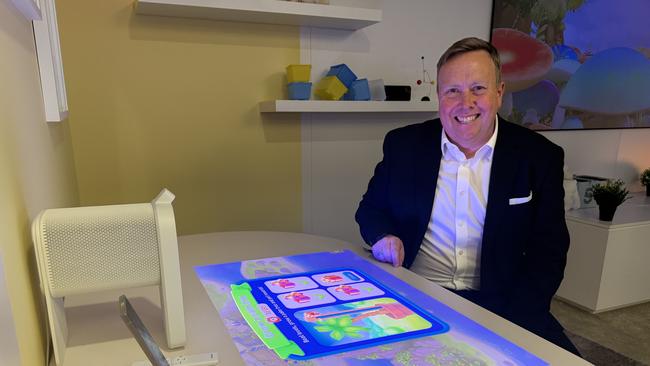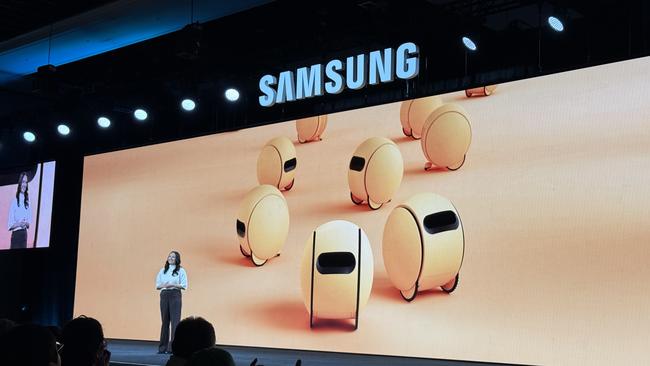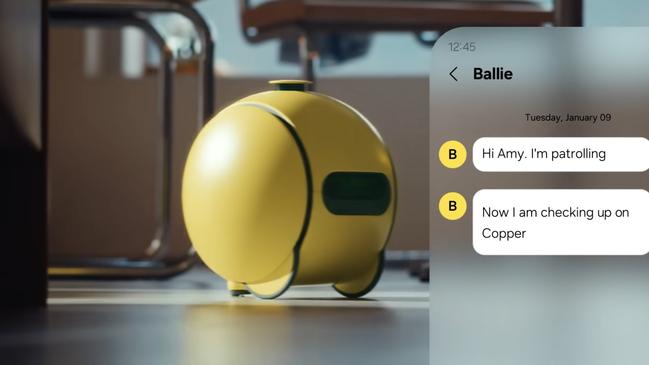Samsung unleashes smart robot assistant in quest to make homes smarter
Samsung is seeking to increase its share in a market worth $2.17 trillion globally, unleashing a wave of new products to realise its decade-long smart home vision.
Samsung says it will release its ‘Ballie’ robot companion later this year as it seeks to make homes, roads and workplaces smarter thanks to artificial intelligence and grow its share in a market worth about $US1.35 trillion ($2.17 trillion) globally.
The Korean tech titan is harnessing AI to save time, money and make “life more comfortable”. Samsung Australia vice president Jeremy Senior said using the technology to optimise wash cycles could shave 60 per cent off the cost of running laundry appliances, for example.
Ballie is Samsung’s concept for personal care and was first unveiled at CES – the world’s biggest consumer electronics show in Las Vegas – as a softball-sized robot in 2020 before it released a revamped version last year.
Now, after four years, a bigger version – closer to the size of a volley ball – is set to roll into homes in coming months, although availability in Australia is yet to be determined.
It is part of Samsung’s broader AI home vision, which began in 2014 when it acquired Smart Things for an estimated $US200m (financial terms were not disclosed at the time).
For the past decade big consumer electronics and appliance companies have been jostling with tech behemoths Amazon, Apple and Google in what is called the Internet of Things. It’s a battle that involves any product that can connect to the internet and controlled by an app or smart panel installed in a home, encompassing speakers, televisions, security cameras and even ovens and fridges.
It’s a market estimated to be worth $US1.35 trillion this year, according to Mordor Intelligence.
Samsung’s Ballie is designed to “learn and evolve” to understand home occupants, providing personalised experiences over time. It can monitor pets with its on-board cameras and send back to users when they’re away from home, project workout videos on the floor or cat games as well as manage other smart appliances.
But Mr Senior said the future of AI-powered appliances was not just confined to the home. Nor do people need a robotic assistant like Ballie to make their lives easier.

He said technology like Samsung’s robot vacuums, which also feature on-board cameras, could be remotely activated by approved users to perform tasks like checking on elderly loved ones if they hadn’t answered the phone.
“A vacuum cleaner is a good example. One thing that causes a lot of people anxiety is to have an elderly loved one and ‘oh, I just want to check in on them because I haven’t heard from them in a while – can’t get them on the phone. So you can potentially navigate the robot vacuum cleaner, which can provide a map of the home … access the camera to find out which room they are in and if everything is OK,” Mr Senior said.
Similarly, if suspicious noises are heard when someone is away from their home, a Samsung vacuum cleaner can notify the user and provide a live feed of what’s happening.
“AI of the future of in the home is out of the home,” Mr Senior said.
“It’s about AI being around you and helping you deliver on those commitments of energy and time savings wherever you are. So you might have AI and connectivity in your car that will allow you to trigger actions in the home on your way home or on the way to the office in the morning.”

Mr Senior smart home devices were also able to optimise energy consumption, by selecting the most accurate and efficient setting to use as well as operating during off-peak times, or if someone has solar panels, when it’s sunny.
“With a Samsung Bespoke AI washing machine we utilise the cold cycle and AI, which can use sensors to detect soiling, test the load size etc. You can save over 60 per cent of your energy consumption on that.”
But how does someone build a smart home and how expensive is the start-up cost? Mr Senior said it was lower than you think, with people not necessarily having to commit to buying solely Samsung or new appliances.
“We’ve made a commitment to be very open source about Smart Things,” Mr Senior said.
“A lot of Australians have a lot of connected devices within their home already, so it’s not necessarily having to go out and buy the product. It’s about understanding how these products can be connected together.
“So I’d suggest download the Smart Things app and see how many of your devices already connect.”

Still many people are concerned about the use of AI in their homes and potential security threats. Hackers have infiltrated devices of some other brands, targeting baby monitors to spy on families, webcams have been hijacked to take down computer networks, and home thermostat settings have been raised to extreme levels.
“When we talk to consumers in Australia and ask them how much they know about AI, they don’t know much but they are scared,” Mr Senior said.
“We know consumers want to feel safe.” To this end, Samsung has integrated its mobile security platform Knox into Smart Things.
“You can have confidence that all of the connected devices on your Smart Things network are working together to protect against vulnerability. So if one device is compromised in one way or the other, the other devices will work to close that out and protect the others in the network,” Mr Senior said.
The author travelled to CES with assistance from Samsung, LG and Hisense.




To join the conversation, please log in. Don't have an account? Register
Join the conversation, you are commenting as Logout